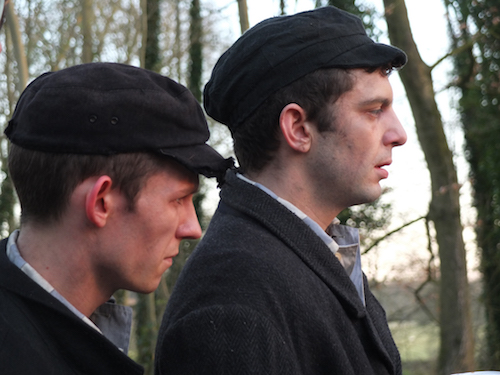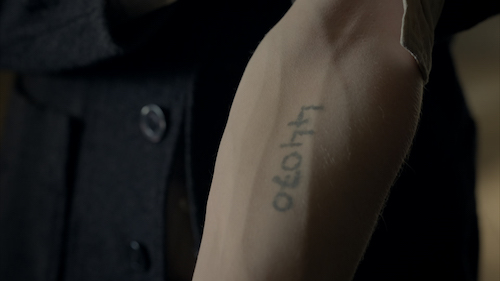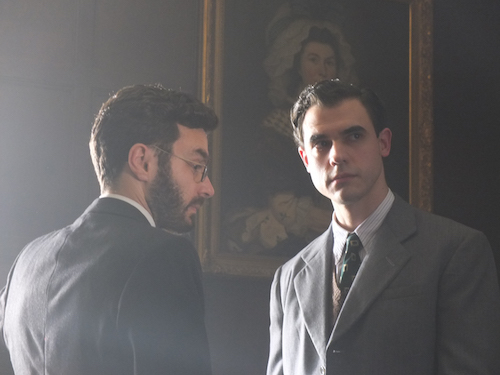Communiqué
Historians, survivors and experts consider one of the great moral dilemmas in “Bombing Auschwitz” on SECRETS OF THE DEAD, Jan. 25 at 10 pm
< < Back to ?p=247572Secrets of the Dead: Bombing Auschwitz
Wednesday, January 25 at 10 p.m. on WOUB
In April 1944, Jewish prisoners Rudolf Vrba and Alfred Wetzler miraculously escaped from Auschwitz concentration camp and fled through Nazi-occupied Poland to find refuge in Žilina, Slovakia, where they connected with the Jewish Underground. Once safe, they recounted what they left behind. Their harrowing testimony revealed the true horror of the Holocaust to the outside world, describing in forensic detail the gas chambers and the full extent of the Nazi extermination program.

While millions of troops fought on both fronts and battled for supremacy in the air during World War II, Nazi forces continued to deport Jews to the concentration camp. As Vrba and Wetzler’s account made its way to Allies, the idea of bombing the camp was discussed at the highest levels of government. Prime Minister Winston Churchill, Allied Air Commanders, the American War Refugee Board and the Jewish Agency were presented with one of the greatest moral questions of the 20th century: Should we bomb Auschwitz and risk killing Jewish prisoners in the camp to stop future atrocities?
Secrets of the Dead: Bombing Auschwitz explores this dilemma through dramatic recreations of arguments that took place on both sides of the Atlantic and first-hand testimony from historians, survivors and expert voices. January 27, 2023, marks the 78th anniversary of the liberation of Auschwitz and International Holocaust Remembrance Day.
Film Interviewees
- Michael Berenbaum – co-editor, “The Bombing of Auschwitz”
- John Bew – author, “RealPolitik: A History”
- Hedy Bohm – Auschwitz survivor
- Judy Cohen – Auschwitz survivor
- Tami Davis Biddle – author, “Rhetoric and Reality in Air Warfare”

Actor David Moorst as Rudolf Vrba shown his prisoner tattoo. - Max Eisen – Auschwitz survivor
- Rebecca Erbelding – author, “Rescue Board: The Untold Story of America’s Efforts to Save the Jews of Europe”
- Zdenka Fantlova – Auschwitz survivor
- Deborah Lipstadt – author, “Beyond Belief: The American Press and the Coming of the Holocaust”
- William D. Rubinstein – author, “The Myth of Rescue”
- Zigi Shipper – Auschwitz survivor
- Gerta Vrbová – first wife of Auschwitz escapee Rudolf Vrba
- Nikolaus Wachsmann – author, “KL: A History of the Nazi Concentration Camps”
- Lenka Weksberg – Auschwitz survivor

Timeline
- April 1944: The harrowing testimony of Rudolf Vrba and Alfred Wetzler, Jewish prisoners who escaped the Auschwitz-Birkenau concentration camp, was turned into a detailed report known as The Auschwitz Protocol.
- May 1944: The Auschwitz Protocol reached Rabbi Michael Weissmandl, who secretly worked for the Jewish Underground in Slovakia. Weissmandl sent the protocol to Roswell McClelland at the War Refugee Board in neutral Switzerland with a plea for help and a demand for Allied air forces to bomb Auschwitz. Later, McClelland sent a cable containing a summary of the protocol and the plea to bomb the camp to the headquarters of the War Refugee Board in Washington, D.C.
- June 29, 1944: War Refugee Board director John Pehle passed the recommendations to bomb Auschwitz to John McCloy, Assistant Secretary of War, who was not inclined to divert resources from the war to stop the mass murder happening at the camp.
- July 6, 1941: Jewish Agency representatives Chaim Weizmann and Moshe Shertok met with Foreign Secretary Anthony Eden in London, where he was presented with The Auschwitz Protocol and a memo from U.K. Prime Minister Winston Churchill urging the bombing of Auschwitz. Eden then summoned Head of Air Ministry Sir Archibald Sinclair to discuss the feasibility of a raid.
- September 13, 1944: Allied forces accidentally bombed Auschwitz, killing 40 prisoners and 15 SS troops, while attempting to bomb a nearby IG Farben factory.
- Early November 1944: John Pehle received the complete The Auschwitz Protocol and shared the report with John McCloy who informed him that bombing Auschwitz was not “feasible from a military standpoint.” Failing to get the War Department involved, Pehle leaked The Auschwitz Protocol to newspapers.
- November 1944: With the tide of the war turning, the Nazis began dismantling the gas chambers at Auschwitz in an effort to destroy evidence of their crimes – and accelerated their efforts with the new media attention.
- December 3, 1944: The Washington Post published an editorial on the atrocities titled “Genocide,” marking the first time the word appeared in a national newspaper.
- January 27, 1945: Nine months after Rudolf Vrba and Alfred Wetzler gave their testimony to the Jewish Underground, Auschwitz was liberated by the Soviet Army.

